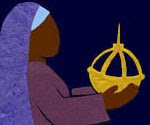Well, just in time for Advent, which starts next Sunday, I finished my plan for an ecumenical D&C study this week by reading sections R145-R153, which form the distinctive canon of the Remnant Church, a 10-year-old organization formed by disaffected conservatives from the Community of Christ. They pick up the numbering of the D&C after 144, the last revelation of Israel A. Smith, since they consider W. Wallace Smith to be the leader who set the church down the road to apostasy. Their revelations have all been produced since 2002 by Fred Larsen, who is president of the Remnant Church by virtue of his being a lineal descendent of Joseph Smith, Jr. (I met Larsen briefly at Restoration Studies in Independence this last year.)
The revelations have an eschatological/millennial bent: these are the last days, the foretold calamities are coming, Zion as the central gathering place must be built up. I don't want to exaggerate that aspect of the revelations, though. This isn't the kind of wild-eyed apocalypticism you encounter in the rural West, i.e., let's head out to a cabin in the wilderness with our guns so we'll escape the nuclear fallout or the long arm of the United Nations. These people, rather, are living in the middle of Independence, Missouri, evidently trying to build some kind of planned community in accordance with the law of consecration, if I'm understanding the revelations correctly. I was struck, though, by a certain tendency to invoke the opposition between Zion and Babylon, reminiscent of 19th-century LDS rhetoric.
As long as I'm talking about rhetoric and imagery, I also noticed that these documents seem partial to the metaphor of Christ as Bridegroom and the Church as Bride. The sexism of that metaphor stands out inescapably in light of the fact that this is a community that rejects ordination of women.
On a more positive note, though, I was struck by the emphasis these revelations placed on the idea that Zion must be built so that Christ can return. "I, the Lord, await the coming forth of my Zion . . ." (R150:8b). "There is a marriage supper waiting. The bridegroom is ready, but the bride is not prepared" (R151:4a). "The time to prepare for my Zion is now, and I desire to come quickly" (R152:7b). In this same strain, the revelations emphasize the need for the Saints to respond so that God's purposes can be accomplished: "The Kingdom of God awaits your response" (R145:7b). "My endowing power awaits your response" (R148:5c). That emphasis accords with (or at least runs parallel to) my personal understanding of Mormon millenarianism, which I read in postmillennial rather than premillennial terms—i.e., it's incumbent on us to bring about the millennial world; Jesus isn't going to come swooping down at the end of time as a literal deus ex machina to do it for us.
A couple other elements of these revelations which resonated with my spirit: First, we get the image of Zion "unfolding" (R147:6b; R148:4b) like "a blossoming flower" (R150:8b). Of course, this is just a reiteration of JS Jr.'s language (in turn borrowed from Isaiah) about "blossoming like a rose." But something about the way the image was used in these documents was particularly vivid to me and gave me a novel image for the coming forth of Zion. Perhaps because I'm accustomed to hearing the "blossom as a rose" language used in connection with Lamanites rather than with Zion. Anyway, I was also struck by what a surprisingly gentle, "feminine" image it was—by contrast, for instance, with the image of the rolling stone from Daniel 2, which shows up here as well (R146:6b).
Second, I was impressed that in his introductions to the revelations, Larsen refers on a couple of occasions to his process including the seeking of confirmation for the revelations. In the intro to R147, for example, he writes that he received the revelation "in response to what I perceived as divine guidance in the early morning hours of September 1, 2003"—kudos for acknowledging the subjective nature of revelation—"and additionally confirmed in direct petition to our heavenly Father on September 19, 2003." A reference to seeking confirmation for a revelation appears as well in the intro to R151. Obviously I think there's more material in these documents that reflects the false traditions of the fathers than Larsen would recognize as such; but I commend the recognition of the possibility of error implicit in the process of seeking confirmation, as well as in the use of expressions like "what I perceived as divine guidance." That seems to me a healthy approach to seeking revelation.
Sunday, November 22, 2009
D&C R145-R153
Subscribe to:
Post Comments (Atom)


No comments:
Post a Comment